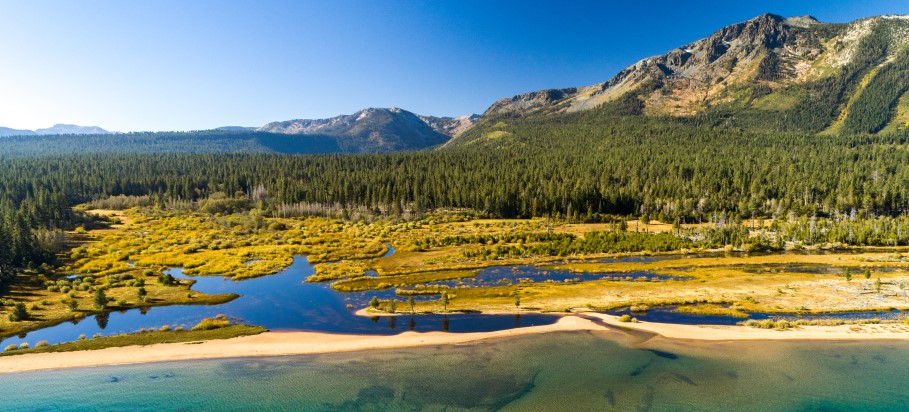By Julie Regan
 Whether you are getting out this weekend for Tahoe’s amazing fall weather or you spent time this summer on the lake, trails, and beaches, you’ve been enjoying some of Lake Tahoe’s greatest assets: hundreds of square miles of public land and water. This Saturday is National Public Lands Day and a timely reminder of how fortunate we are that conservation programs under the Lake Tahoe Regional Plan have protected open space, set aside approximately 9,000 vacant lots in residential neighborhoods, and added more than a half mile of public shoreline.
Whether you are getting out this weekend for Tahoe’s amazing fall weather or you spent time this summer on the lake, trails, and beaches, you’ve been enjoying some of Lake Tahoe’s greatest assets: hundreds of square miles of public land and water. This Saturday is National Public Lands Day and a timely reminder of how fortunate we are that conservation programs under the Lake Tahoe Regional Plan have protected open space, set aside approximately 9,000 vacant lots in residential neighborhoods, and added more than a half mile of public shoreline.
With multiple threats emerging from climate change, aquatic invasive species, wildfire, and impacts around outdoor recreation and tourism, this Public Lands Day must be the call to step up our stewardship of Lake Tahoe’s incredible public recreation resources. The lake and land here are the public’s playground, but this comes with a deep and sacred responsibility to preserve them to enjoy today and in the future, while working to improve access for all.
The news this week that invasive New Zealand mudsnails have been discovered in Lake Tahoe comes at a time when warming temperatures and the cross-cutting impacts of climate change are challenging all of us to double down on our protection of these resources.
Aquatic invasive species (AIS) pose serious threats to Tahoe’s water quality and native species. The rising temperature of the lake, warmer winters, and extreme storms combined with prolonged drought all increase the chances that invasive fish, plants, and shelled animals can take hold and spread here.
The Tahoe Regional Planning Agency (TRPA) and our partners in the Lake Tahoe Aquatic Invasive Species Program have been taking determined steps to protect the lake from new and existing invaders. Now in its 15th year, the program’s collaborative, science-based planning has helped put preparations in place to respond quickly to the New Zealand mudsnail discovery. In fact, it was planned surveys of the lake bottom by divers working for the program that led to the detection and identification of the new invasive species off the South Shore.
Actions since the species was confirmed have followed protocols of the Early Detection and Rapid Response Plan. An incident team from TRPA and Tahoe Resource Conservation District (Tahoe RCD) has mobilized multiple dive contractors that were in the wings to complete a lake-wide survey. We expect to have more information and findings in the coming weeks and will be sharing information as it is available.
Our minds quickly go to “how” and “why” in an incident like this. Aquatic invasive species can be transported on boats and boat systems, trailers, non-motorized craft, fishing gear, and even life jackets and water toys. If not Clean, Drain, and Dry, which is the call of aquatic invasive species prevention everywhere, everyday gear of “life on the lake” can increase the risk of their spread to different waterbodies.
Earlier this month, the same divers with Marine Taxonomic Services, Ltd. who discovered the New Zealand mudsnails were working in Emerald Bay to remove aquatic invasive weeds from a project area that had been weed-free for nearly 10 years. In total, 200 acres of the lake bottom have been treated so far to reduce aquatic invasive weeds and Asian clams here before TRPA and Tahoe RCD established one of the nation’s first fully mandatory motorized watercraft inspection programs in 2008.
Since then, we have worked collaboratively to redefine AIS prevention and created a program that is considered the gold standard for the nation. Boat inspectors have conducted more than 107,000 inspections and led innovation in watercraft decontamination and efficiency. We are also making the basin safer by building partnerships throughout the West and strengthening programs nationally.
Aquatic invasive species threaten more than Tahoe as well. As we are responding to the New Zealand mudsnail here, wildlife managers in Idaho have confirmed the presence of larvae of the highly destructive quagga mussel in the Snake River, a massive watershed that connects four states to the Pacific Ocean.
While there is no silver lining when it comes to a new invasive species discovery, having one of the most protective and collaborative programs in the nation is playing a big role in how TRPA and our partners are managing the newest threat to the lake. We appreciate you sharing our dedication to protecting the waters of the Lake Tahoe Region and for continuing to support the aquatic invasive species program.
Learn more about the New Zealand mudsnail and what you can do to protect our lake and lands on our aquatic invasive species pages.
Julie Regan is Executive Director of the Tahoe Regional Planning Agency

